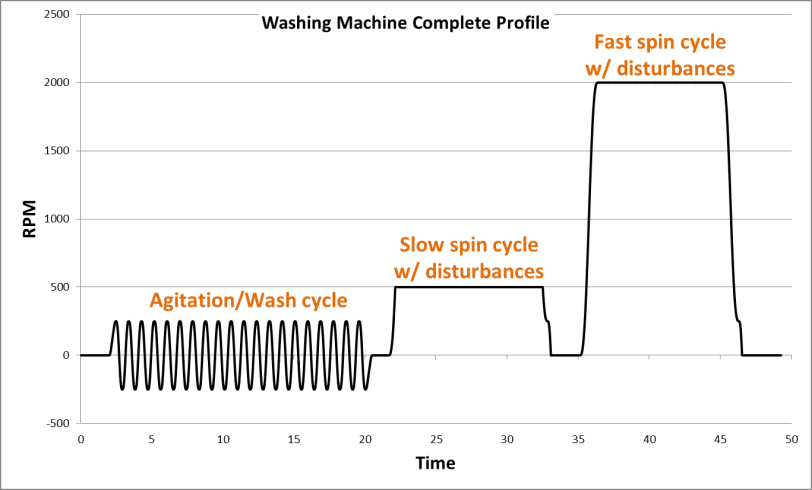SPRUHW1A June 2014 – October 2021 TMS320F28052-Q1 , TMS320F28052M , TMS320F28052M-Q1 , TMS320F28054-Q1 , TMS320F28054M , TMS320F28054M-Q1
- 1Read This First
- 1 F2805xM InstaSPIN-MOTION Enabled MCUs
- 2InstaSPIN-MOTION Key Capabilities and Benefits
- 3InstaSPIN-MOTION Block Diagrams
- 4Application Examples
- 5Evaluating InstaSPIN-MOTION Performance
- 6Microcontroller Resources
4.3 Washing Machine: Smooth Motion and Position Accuracy at Low Speeds
Cycle transitions, changing loads, and environmental disturbances cause significant wear and tear on motors. Automatic, real-time reduction of disturbances can extend the life and performance of motors.
Consider washing machines, for example. Figure 5-1 displays the motion profile for three stages of a standard washing machine. The first stage represents the agitation cycle, rotating between 250 rpm and -250 rpm, repeatedly. The second and third stages represent two different spin cycles. The second stage spins at 500 rpm and the third stage spins at 2000 rpm. This profile was easily created using SpinTAC Plan (documented in the InstaSPIN-FOC and InstaSPIN-MOTION User's Guide).
InstaSPIN-MOTION was applied to a washing machine application. The SpinTAC Plan trajectory planning feature was used to quickly build various states of motion (speed A to speed B) and tie them together with state based logic (see Figure 3-4).
The washing machine application was run twice — once using a standard PI controller and once using LineStream's SpinTAC controller. The data was then plotted against the reference curve for comparison.
 Figure 4-1 Washing Machine Profile
Figure 4-1 Washing Machine Profile